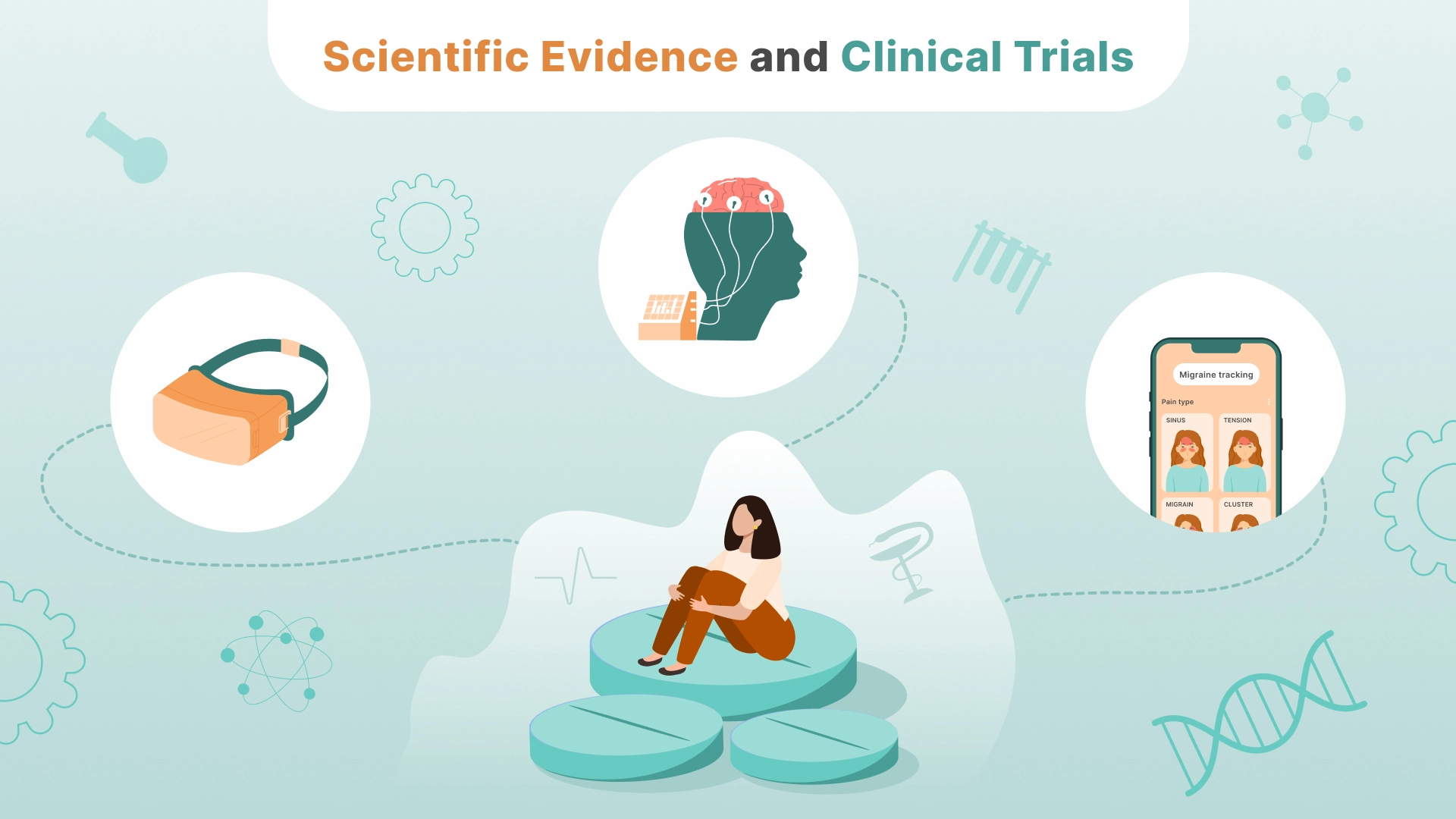

Digital Therapies Poised for Breakthrough in Migraine Treatment
Migraine, a debilitating neurological disorder characterized by severe headaches, affects millions of people worldwide. Those who suffer from migraines understand the agony of these recurring episodes, which often come with nausea and sensitivity to light and sound, and can last for hours or even days. While traditional treatments, such as medications and lifestyle adjustments, have been the mainstay for migraine management, a new frontier in the fight against migraines is emerging — digital therapies.
The Current Landscape of Migraine Treatment
For decades, individuals grappling with migraines have relied on a limited array of treatment options. These have included pain-relieving medications, lifestyle modifications like avoiding triggers, and relaxation techniques. However, these treatments are not always effective, and some individuals experience unwanted side effects from medications. Moreover, the quest for more tailored, precise treatments has led researchers and healthcare professionals to explore innovative approaches.
The Emergence of Digital Therapies
Digital therapies represent a promising avenue for migraine treatment. These therapies leverage technology to provide personalized and often non-pharmacological interventions. Unlike traditional treatments, which typically rely on pharmaceuticals, digital therapies offer a novel approach to managing migraines.
Types of Digital Therapies for Migraine
Digital therapies encompass a diverse range of innovative approaches to migraine management, each offering unique benefits. These therapies leverage technology to provide personalized and often non-pharmacological interventions, making them a promising addition to the migraine treatment landscape.
Mobile Health Apps for Migraine Management
Mobile applications designed for migraine management have gained popularity in recent years. These apps offer a user-friendly platform for tracking and monitoring migraine symptoms, triggers, and patterns. They often include features such as:
Migraine Diary: Users can log details of each migraine episode, including pain intensity, duration, associated symptoms, and potential triggers.
Trigger Identification: Some apps help users identify potential migraine triggers by analyzing data over time, allowing for better avoidance strategies.
Medication Reminders: Users can set reminders for taking medications or supplements as prescribed by their healthcare provider.
Personalized Insights: Through data analysis, these apps can provide personalized insights and recommendations for migraine management.
Community Support: Many migraine apps have built-in communities where users can share experiences and tips for managing migraines.
Examples of popular migraine management apps include Migraine Buddy, Migraine Coach, and Curelator N1-Headache.
Virtual Reality (VR) Therapy for Migraine
Virtual reality therapy is an immersive and cutting-edge approach to migraine management. It involves the use of VR headsets to transport individuals to calming and engaging virtual environments, which can help alleviate migraine symptoms. Key aspects of VR therapy for migraine include:
Distraction and Relaxation: VR environments can distract individuals from their pain and induce relaxation, potentially reducing the severity and duration of migraine attacks.
Biofeedback Integration: Some VR systems incorporate biofeedback mechanisms, allowing users to control physiological responses and enhance relaxation.
Customizable Environments: Users can select environments that suit their preferences, from serene natural landscapes to tranquil underwater worlds.
Studies have shown that VR therapy can significantly reduce migraine frequency, intensity, and the need for medication in some individuals.
Platforms for Cognitive-Behavioral Therapy (CBT) and Biofeedback
Such platforms offer a versatile approach to migraine management, incorporating techniques such as cognitive-behavioral therapy and biofeedback. Key features of the solutions include:
Cognitive-Behavioral Therapy: These platforms often provide CBT programs tailored to address the psychological aspects of migraine, helping individuals better cope with pain and stress.
Biofeedback Training: Users can access biofeedback exercises that teach them to control physiological responses like muscle tension and heart rate, which can contribute to migraine triggers.
Progress Tracking: Individuals can monitor their progress and receive feedback on their efforts in real time.
Telehealth Integration: Some platforms offer telehealth services, enabling users to connect with healthcare professionals for guidance and support.
Platforms for migraine management aim to empower individuals with effective self-help tools and strategies, reducing the impact of migraines on their daily lives.
Scientific Evidence and Clinical Trials

Scientific research has been pivotal in validating the potential of digital therapies in the treatment of migraines. Clinical studies have provided compelling evidence of their effectiveness:
In a randomized controlled trial published in the journal JAMA Neurology, participants who used VR therapy experienced significantly reduced migraine frequency and intensity compared to those who did not use VR.
Biofeedback and neurofeedback techniques have shown promise in multiple studies. For instance, a study in the journal Headache: The Journal of Head and Face Pain found that patients who underwent biofeedback training reported a significant decrease in the number of migraine days per month.
Mobile applications and wearable devices have enabled users to track and analyze migraine patterns. A study in the Journal of Medical Internet Research demonstrated that individuals who used a migraine-tracking app reported improved migraine management and better communication with healthcare providers.
Advantages of Digital Therapies in Migraine Treatment
Digital therapies offer several advantages that make them particularly promising for migraine management:
Accessibility and Convenience: Digital therapies can be accessed from the comfort of one’s home, reducing the need for frequent doctor visits.
Personalization: These therapies can be tailored to individual needs and migraine triggers, ensuring a more precise approach to treatment.
Real-time Monitoring: Mobile health apps and wearables provide real-time data, allowing users to make immediate adjustments and gain insights into their migraine patterns.
Challenges and Considerations
Cost and Accessibility
The initial expense of acquiring equipment, such as VR headsets or wearable devices, can be a barrier for some individuals. Furthermore, subscription fees for certain mobile health apps or platforms might be an ongoing expense. Ensuring affordability and accessibility to a diverse range of users remains a priority in making these therapies widely available.
Professional Guidance
While many digital therapies are user-friendly, guidance from healthcare professionals can be crucial for optimal results. This includes initial setup and training, as well as ongoing monitoring and adjustments.
Data Privacy and Security
Collecting and storing personal health data, as is often the case with mobile health apps and platforms, raises concerns about data privacy and security. Users should have confidence that their sensitive health information is protected from unauthorized access or breaches.
User Engagement and Adherence
Some individuals may struggle with adherence to therapy plans or may lose interest over time. Developers are continually working on strategies to enhance user motivation and adherence through gamification, rewards, and user-friendly interfaces.
Integration with Traditional Treatments
Digital therapies should ideally complement, rather than replace, traditional migraine treatments. Achieving seamless integration with existing treatments and healthcare practices is a complex challenge. Coordinating care between digital therapy providers and healthcare professionals to ensure a holistic approach to migraine management remains a goal.
As digital therapies for migraine management continue to advance, solutions to these challenges will likely emerge, making these innovative treatments even more accessible and effective for individuals living with migraines.
The Future of Migraine Treatment: Integrating Digital Therapies
As digital therapies continue to advance, they hold the promise of becoming an integral part of standard migraine treatment protocols. The convergence of technology and healthcare is opening up exciting possibilities for how these therapies may shape the future of migraine management.
More Advanced Wearables and Sensors: Wearable devices are expected to become more sophisticated and capable of providing real-time data. These devices will likely integrate advanced sensors that can monitor physiological indicators, such as changes in blood pressure, muscle tension, or brainwave patterns.
AI and Personalization: Advancements in AI and machine learning will enhance the personalization of migraine treatment. AI algorithms can analyze vast amounts of data to identify individual triggers and predict impending migraine attacks. Treatment plans can be automatically adjusted based on these insights, ensuring that interventions are timely and effective.
Big Data and Research Collaboration: The collection and analysis of extensive user data generated by digital therapies will contribute to ongoing migraine research. Researchers will have access to large datasets, allowing them to identify trends, refine treatment strategies, and develop new therapies.
Patient Empowerment and Self-Management: Digital therapies empower individuals to take a more active role in their migraine management. As these tools become more user-friendly and engaging, individuals will have greater control over their condition.
In Conclusion
The landscape of migraine treatment is shifting with the emergence of digital therapies. While traditional treatments remain valuable, these innovative approaches offer new hope to migraine sufferers. With scientific evidence supporting their effectiveness and ongoing developments in technology, digital therapies are poised for a breakthrough in migraine treatment. As they become more accessible and integrated into healthcare systems, they have the potential to transform the lives of millions by providing effective, personalized, and convenient solutions for managing this debilitating condition.
Faq
What are digital therapies, and how do they differ from traditional migraine treatments?
+Digital therapies are computer or smartphone-based interventions designed to treat various health conditions, including migraines with cognitive-behavioral therapy, relaxation techniques, etc. Unlike traditional migraine treatments such as medication, digital therapies offer a non-pharmacological approach, focusing on behavioral and psychological aspects to help manage and reduce migraine symptoms.
How do digital therapies contribute to the breakthroughs in migraine treatment?
+Digital therapies for migraine treatment offer a multifaceted approach, providing patients with personalized interventions. They enable continuous monitoring of triggers, symptoms, and treatment progress, allowing for real-time adjustments and care optimization. Additionally, they empower individuals to actively manage their condition, ultimately leading to more effective outcomes.
What types of digital therapies are available for migraine management, and how effective are they?
+Digital therapies for migraine management include mobile health apps, virtual reality (VR) programs, and web-based platforms that offer relaxation techniques, cognitive-behavioral therapy, and biofeedback. Their effectiveness varies, with some studies showing promising results in reducing migraine frequency and severity. However, these digital therapies are often used as part of a comprehensive migraine management plan.
Tell us about your project
Fill out the form or contact us

Tell us about your project
Thank you
Your submission is received and we will contact you soon
Follow us
